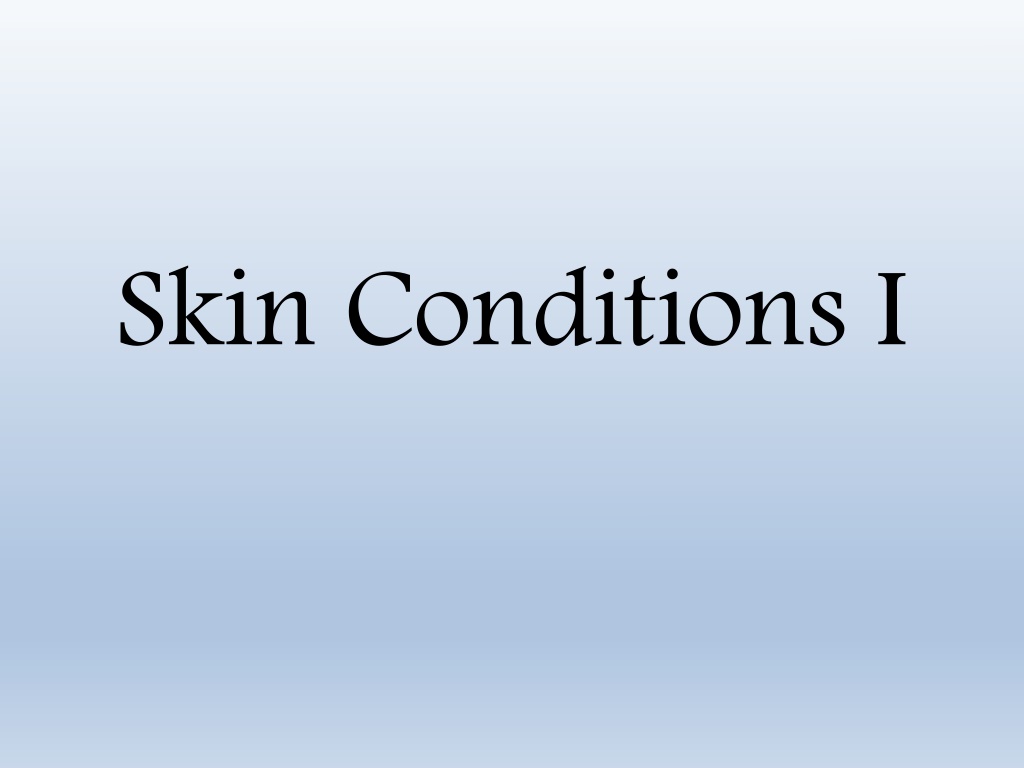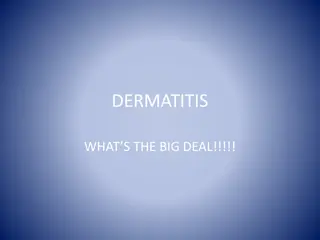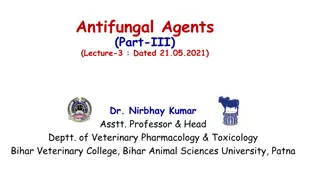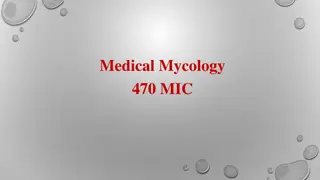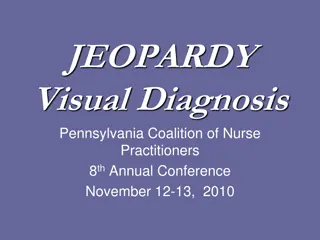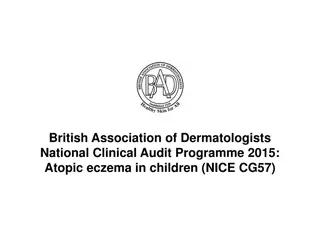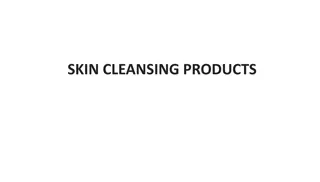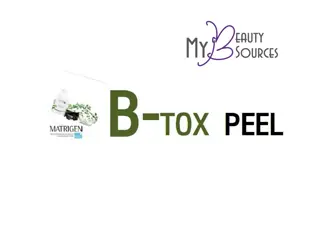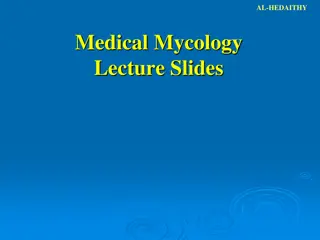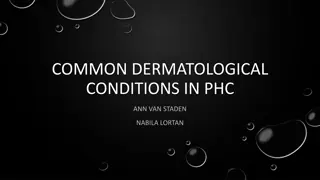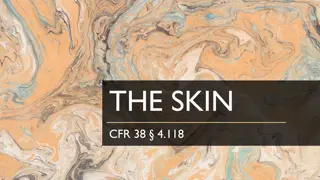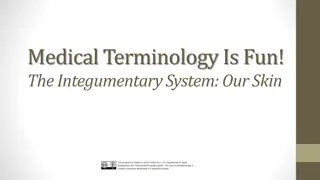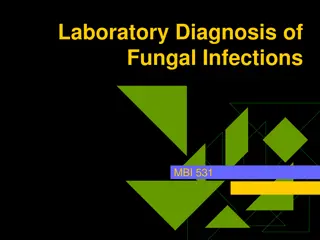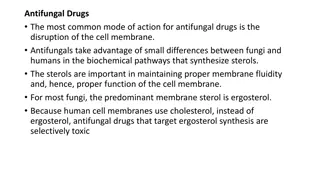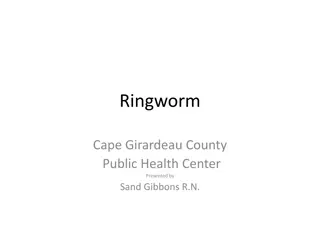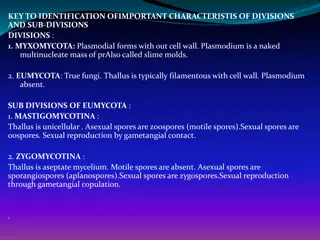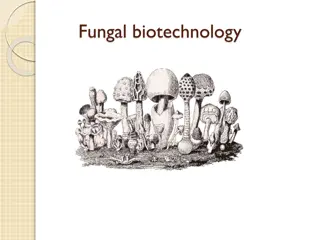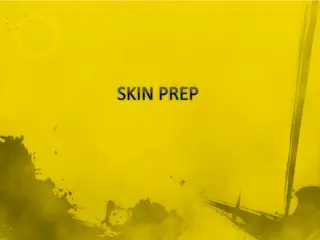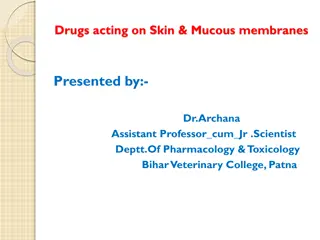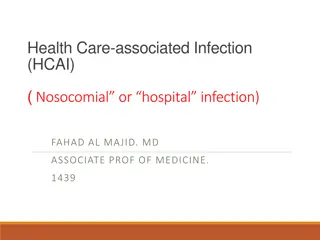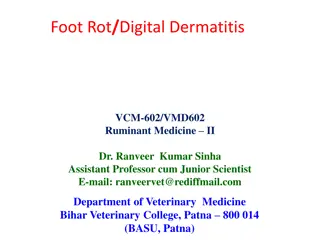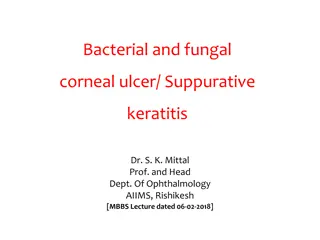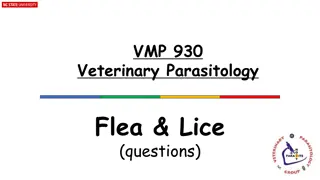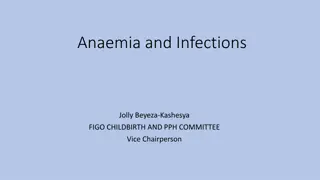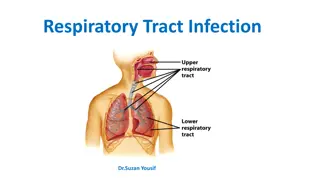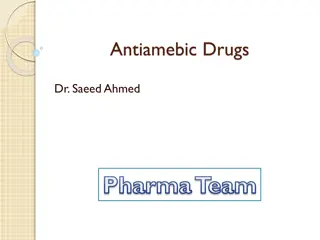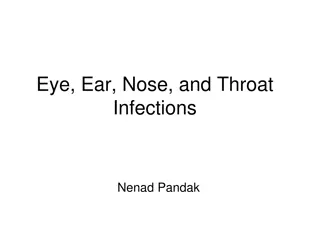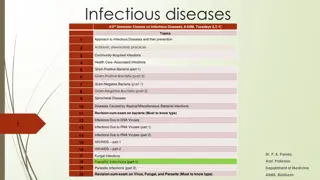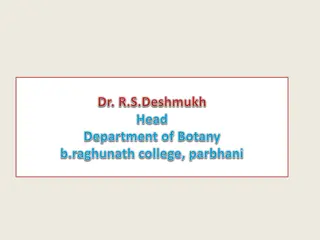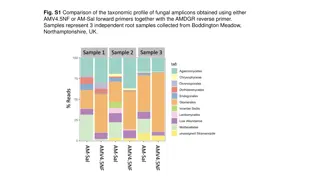Understanding Fungal Skin Infections and Eczema/Dermatitis
Learn about fungal skin infections like Athlete's foot and ways to manage them, including symptoms, treatment options, and when to seek medical attention. Additionally, explore common skin conditions such as eczema and dermatitis, their causes, and typical symptoms in this informative guide.
Download Presentation

Please find below an Image/Link to download the presentation.
The content on the website is provided AS IS for your information and personal use only. It may not be sold, licensed, or shared on other websites without obtaining consent from the author. Download presentation by click this link. If you encounter any issues during the download, it is possible that the publisher has removed the file from their server.
E N D
Presentation Transcript
Fungal Skin Infection/ Athletes foot Site Site Name Name Scalp Scalp Tinea Tinea capitis capitis Feet Feet Tinea Tinea pedis pedis Groin Groin Tinea Tinea cruris cruris Body Body Tinea Tinea corporis corporis Nails Nails Tinea Tinea unguium unguium ( (onychomycosis onychomycosis) )
The fungus that causes the disease thrives in warm, moist conditions. The problem is more common in men than in women and responds well to OTC treatment.
Patient Assessment Patient Assessment Appearance Severity Location Previous history Medication
When to Refer When to Refer Severe, affecting other parts of the foot Signs of bacterial infection Unresponsive to appropriate treatment Diabetic patients Involvement of toenails
Management 2 weeks Management Pharmacists should instruct patients on how to use the treatment correctly to prevent recurrence. Clean and dry your feet. treatment must be continued for 1 2 weeks after the disappearance of all signs of infection to ensure eradication of the fungus Pharmacists should instruct patients on how to use the treatment correctly to prevent recurrence.
Topical Anti Topical Anti- -fungal fungal Azoles Terbinafine Griseofulvin Tolnaftate Undecenoates Hydrocortisone Azoles ( (Miconazole Terbinafine Griseofulvin Tolnaftate Undecenoates (e.g. zinc Hydrocortisone Miconazole, , clotrimazole clotrimazole, , ketconazole ketconazole) ) (e.g. zinc undecenoate undecenoate) )
Eczema/dermatitis Skin conditions characterized by dryness, erythema, and itch of the skin, often with weeping and crusting. Contact dermatitis (irritation or allergy). Atopic eczema (with endogenous cause ).
Contact dermatitis & Atopic eczema Atopic eczema. Typical eczema dermatitis rash
Patient assessment Patient assessment Age/distribution Age/distribution Occupation/contact Occupation/contact History of hay fever/asthma History of hay fever/asthma Severity Severity
Aggravating Factors Aggravating Factors hay-fever season. house dust or animal danders. soaps or detergents and cold wind (dry the skin ). Certain clothing such as woollen material can irritate the skin. Cow s milk, eggs and some food colouring. Emotional factors, stress and worry. Antiseptic solutions applied directly to the skin or added to the bathwater.
Medication Medication Contact dermatitis may be caused or made worse by sensitisation to topical medicaments. Topically applied antihistamines, antibiotics and antiseptics can all provoke allergic preservatives may cause sensitisation. Failed medication need referral. local anaesthetics, dermatitis. Some
When to refer When to refer Evidence of infection (weeping, crusting, spreading) Severe condition: badly fissured/cracked skin, bleeding Failed medication No identifiable cause (unless previously diagnosed as eczema) Duration of longer than Evidence of infection (weeping, crusting, spreading) Severe condition: badly fissured/cracked skin, bleeding Failed medication No identifiable cause (unless previously diagnosed as eczema) Duration of longer than 2 2 weeks weeks
Treatment Timescale Treatment Timescale (1 week) Non Non- -pharmacological advices pharmacological advices Managing the itch Avoiding the irritant (e.g.: wearing gloves to protect the skin). Maintaining the skin integrity.
Pharmacological Treatment Pharmacological Treatment Emollients Emollients Topical corticosteroids Topical corticosteroids Antipruritics Antipruritics
Acne Acne vulgaris is a common condition in young people. It is not usually serious and resolves in most patients by the age of 25. Peak incidence of acne is 14 17 years in females and 16 19 years in males. The condition normally resolves in the majority of patients within 10 years of onset.
Etiology Etiology The hormonal changes especially the production of androgens Increased keratin adolescence leads to blockages of the follicles and the formation of microcomedones A microcomedone can develop into a non inflammatory (blackhead) or closed (whitehead), or into an inflammatory Excess sebum encourages the growth of bacteria, particularly Propionibacterium acnes, which are involved in the development of inflammatory lesions. androgens. keratin and sebum production during microcomedones. non- - inflammatory lesion (comedone comedone), which may be open inflammatory lesion (papule, pustule or nodule).
Patient Assessment Patient Assessment Age Age Severity Severity Affected areas Affected areas Medication Medication
Severity Severity 1. 1. Mild comedones with few inflammatory (papulopustular) lesions mainly confined to the face. Mild acne is therefore characterized by the presence of a few to several pustules 2. 2. Moderate inflammatory Lesions are often painful and there is a possibility of mild scaring. 3. 3. Severe characteristics of moderate acne plus cysts and chest. Scarring will usually result. Mild acne acne: : Patients with predominately open and closed several papules papules and and pustules the, Moderate acne inflammatory lesions the, but acne: : A patient with moderate acne has many lesions that are not confined to the face. but not not nodules nodules many Severe acne acne: : A patient with severe acne has all the plus the the development development of of cysts. Lesions are often widespread involving the upper back
When to refer When to refer Moderate and Severe acne Failed medication Suspected drug-induced acne
Management Management Benzoyl peroxide cream) Benzoyl peroxide (2.5%, 5%, and 10% gels, lotion, cream) (2.5%, 5%, and 10% gels, lotion, Antibacterials Antibacterials Topical Topical Retinoids Retinoids ( (Adapalene Adapalene/ / Differin Differin Gel 0.1%) Gel 0.1%)
Practical points Practical points Diet Diet Continuous treatment Continuous treatment Skin hygiene Skin hygiene Topical hydrocortisone and acne Topical hydrocortisone and acne
Treatment timescale improved within 8 weeks Treatment timescale Only mild acne can be managed by the pharmacist using OTC products, moderate and severe acne should be referred.
Cold Sore The virus responsible is the herpes simplex virus (HSV) of which there are two major types: HSV1 and HSV2.
Patient Assessment Patient Assessment Age and Duration Symptoms and appearance Location Precipitating factors Previous history (help in diagnosis) Medication Age and Duration Symptoms and appearance Location Precipitating factors Previous history (help in diagnosis) Medication
When to refer When to refer Babies and young children Failure of an established sore to resolve Severe or worsening sore (widespread) History of frequent cold sores Sore lasting longer than 2 weeks Painless sore (like in oral cancer) Patients with atopic eczema Eye affected Uncertain diagnosis Immunocompromised patient
Management Management Aciclovir Aciclovir and and Penciclovir Penciclovir cream cream Bland creams (e.g. Bland creams (e.g. cetrimide cetrimide/ / celavex celavex cream) cream) Hydrocolloid patch Hydrocolloid patch
Advices to preventing cross Advices to preventing cross- -infection infection
